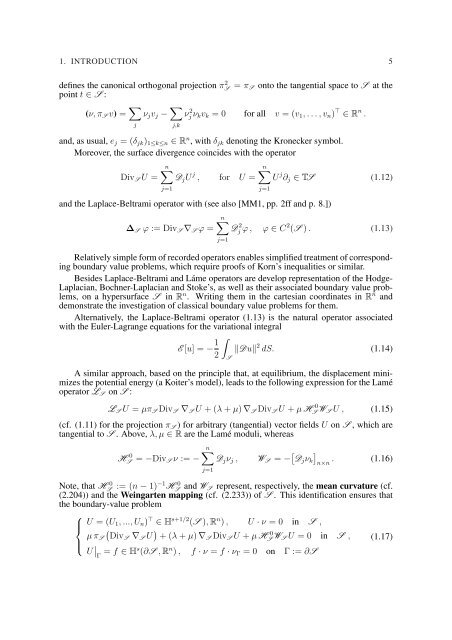EQUATIONS OF ELASTIC HYPERSURFACES
EQUATIONS OF ELASTIC HYPERSURFACES
EQUATIONS OF ELASTIC HYPERSURFACES
You also want an ePaper? Increase the reach of your titles
YUMPU automatically turns print PDFs into web optimized ePapers that Google loves.
1. INTRODUCTION 5<br />
defines the canonical orthogonal projection π 2 S = π S onto the tangential space to S at the<br />
point t ∈ S :<br />
(ν, π S v) = ∑ j<br />
ν j v j − ∑ j,k<br />
ν 2 j ν k v k = 0 for all v = (v 1 , . . . , v n ) ⊤ ∈ R n .<br />
and, as usual, e j = (δ jk ) 1≤k≤n ∈ R n , with δ jk denoting the Kronecker symbol.<br />
Moreover, the surface divergence coincides with the operator<br />
Div S U =<br />
n∑<br />
D j U j , for U =<br />
j=1<br />
n∑<br />
U j ∂ j ∈ TS (1.12)<br />
and the Laplace-Beltrami operator with (see also [MM1, pp. 2ff and p. 8.])<br />
∆ S ϕ := Div S ∇ S ϕ =<br />
j=1<br />
n∑<br />
Dj 2 ϕ , ϕ ∈ C 2 (S ) . (1.13)<br />
j=1<br />
Relatively simple form of recorded operators enables simplified treatment of corresponding<br />
boundary value problems, which require proofs of Korn’s inequalities or similar.<br />
Besides Laplace-Beltrami and Láme operators are develop representation of the Hodge-<br />
Laplacian, Bochner-Laplacian and Stoke’s, as well as their associated boundary value problems,<br />
on a hypersurface S in R n . Writing them in the cartesian coordinates in R n and<br />
demonstrate the investigation of classical boundary value problems for them.<br />
Alternatively, the Laplace-Beltrami operator (1.13) is the natural operator associated<br />
with the Euler-Lagrange equations for the variational integral<br />
E [u] = − 1 ∫<br />
‖Du‖ 2 dS. (1.14)<br />
2<br />
A similar approach, based on the principle that, at equilibrium, the displacement minimizes<br />
the potential energy (a Koiter’s model), leads to the following expression for the Lamé<br />
operator L S on S :<br />
S<br />
L S U = µπ S Div S ∇ S U + (λ + µ) ∇ S Div S U + µ H 0<br />
S W S U , (1.15)<br />
(cf. (1.11) for the projection π S ) for arbitrary (tangential) vector fields U on S , which are<br />
tangential to S . Above, λ, µ ∈ R are the Lamé moduli, whereas<br />
H 0<br />
S = −Div S ν := −<br />
n∑<br />
D j ν j , W S = − [ D j ν k<br />
]n×n . (1.16)<br />
j=1<br />
Note, that HS 0 := (n − 1)−1 HS 0 and W S represent, respectively, the mean curvature (cf.<br />
(2.204)) and the Weingarten mapping (cf. (2.233)) of S . This identification ensures that<br />
the boundary-value problem<br />
⎧<br />
⎪⎨<br />
⎪⎩<br />
U = (U 1 , ..., U n ) ⊤ ∈ H s+1/2 (S ), R n ) , U · ν = 0 in S ,<br />
µ π S<br />
(<br />
DivS ∇ S U ) + (λ + µ) ∇ S Div S U + µ H 0<br />
S W S U = 0 in S ,<br />
U ∣ ∣<br />
Γ<br />
= f ∈ H s (∂S , R n ) , f · ν = f · ν Γ = 0 on Γ := ∂S<br />
(1.17)

















